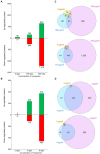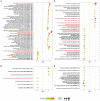Responses of carbapenemase-producing and non-producing carbapenem-resistant Pseudomonas aeruginosa strains to meropenem revealed by quantitative tandem mass spectrometry proteomics
- PMID: 36845973
- PMCID: PMC9948630
- DOI: 10.3389/fmicb.2022.1089140
Responses of carbapenemase-producing and non-producing carbapenem-resistant Pseudomonas aeruginosa strains to meropenem revealed by quantitative tandem mass spectrometry proteomics
Abstract
Pseudomonas aeruginosa is an opportunistic pathogen with increasing incidence of multidrug-resistant strains, including resistance to last-resort antibiotics, such as carbapenems. Resistances are often due to complex interplays of natural and acquired resistance mechanisms that are enhanced by its large regulatory network. This study describes the proteomic responses of two carbapenem-resistant P. aeruginosa strains of high-risk clones ST235 and ST395 to subminimal inhibitory concentrations (sub-MICs) of meropenem by identifying differentially regulated proteins and pathways. Strain CCUG 51971 carries a VIM-4 metallo-β-lactamase or 'classical' carbapenemase; strain CCUG 70744 carries no known acquired carbapenem-resistance genes and exhibits 'non-classical' carbapenem-resistance. Strains were cultivated with different sub-MICs of meropenem and analyzed, using quantitative shotgun proteomics based on tandem mass tag (TMT) isobaric labeling, nano-liquid chromatography tandem-mass spectrometry and complete genome sequences. Exposure of strains to sub-MICs of meropenem resulted in hundreds of differentially regulated proteins, including β-lactamases, proteins associated with transport, peptidoglycan metabolism, cell wall organization, and regulatory proteins. Strain CCUG 51971 showed upregulation of intrinsic β-lactamases and VIM-4 carbapenemase, while CCUG 70744 exhibited a combination of upregulated intrinsic β-lactamases, efflux pumps, penicillin-binding proteins and downregulation of porins. All components of the H1 type VI secretion system were upregulated in strain CCUG 51971. Multiple metabolic pathways were affected in both strains. Sub-MICs of meropenem cause marked changes in the proteomes of carbapenem-resistant strains of P. aeruginosa exhibiting different resistance mechanisms, involving a wide range of proteins, many uncharacterized, which might play a role in the susceptibility of P. aeruginosa to meropenem.
Keywords: Pseudomonas aeruginosa; carbapenem-resistance; extensively-drug resistant; high-risk clones; multidrug resistance; nano-LC–MS/MS; quantitative shotgun proteomics; tandem mass tag.
Copyright © 2023 Salvà-Serra, Jaén-Luchoro, Marathe, Adlerberth, Moore and Karlsson.
Conflict of interest statement
RK was affiliated to the company Nanoxis Consulting AB. The company did not have influence on the conception, elaboration, and decision to submit the present research article. The remaining authors declare that the research was conducted in the absence of any commercial or financial relationships that could be construed as a potential conflict of interest.
Figures






Similar articles
-
Bulgecin A as a β-lactam enhancer for carbapenem-resistant Pseudomonas aeruginosa and carbapenem-resistant Acinetobacter baumannii clinical isolates containing various resistance mechanisms.Drug Des Devel Ther. 2016 Sep 20;10:3013-3020. doi: 10.2147/DDDT.S110193. eCollection 2016. Drug Des Devel Ther. 2016. PMID: 27703329 Free PMC article.
-
Liquid Chromatography-Tandem Mass Spectrometry Analysis Demonstrates a Decrease in Porins and Increase in CMY-2 β-Lactamases in Escherichia coli Exposed to Increasing Concentrations of Meropenem.Front Microbiol. 2022 Feb 28;13:793738. doi: 10.3389/fmicb.2022.793738. eCollection 2022. Front Microbiol. 2022. PMID: 35295306 Free PMC article.
-
Cefiderocol: A Siderophore Cephalosporin with Activity Against Carbapenem-Resistant and Multidrug-Resistant Gram-Negative Bacilli.Drugs. 2019 Feb;79(3):271-289. doi: 10.1007/s40265-019-1055-2. Drugs. 2019. PMID: 30712199 Review.
-
In vitro antibacterial activity of rifampicin in combination with imipenem, meropenem and doripenem against multidrug-resistant clinical isolates of Pseudomonas aeruginosa.BMC Infect Dis. 2016 Aug 24;16(1):444. doi: 10.1186/s12879-016-1785-7. BMC Infect Dis. 2016. PMID: 27553962 Free PMC article.
-
Molecular epidemiology of carbapenem-resistant Pseudomonas aeruginosa in an endemic area: comparison with global data.Eur J Clin Microbiol Infect Dis. 2018 Jul;37(7):1211-1220. doi: 10.1007/s10096-018-3244-4. Epub 2018 Apr 11. Eur J Clin Microbiol Infect Dis. 2018. PMID: 29644540 Review.
Cited by
-
Seasonal meropenem resistance in Acinetobacter baumannii and influence of temperature-driven adaptation.BMC Microbiol. 2024 Apr 27;24(1):149. doi: 10.1186/s12866-024-03271-y. BMC Microbiol. 2024. PMID: 38678219 Free PMC article.
-
Antioxidant and Antibacterial Activities Evaluation, Phytochemical Characterisation of Rhizome from Angiopteris helferiana and Barks from Saurauia fasciculata in Nepal.ScientificWorldJournal. 2024 Jun 12;2024:1119165. doi: 10.1155/2024/1119165. eCollection 2024. ScientificWorldJournal. 2024. PMID: 38898935 Free PMC article.
-
Amber-codon suppression for spatial localization and in vivo photoaffinity capture of the interactome of the Pseudomonas aeruginosa rare lipoprotein A lytic transglycosylase.Protein Sci. 2023 Oct;32(10):e4781. doi: 10.1002/pro.4781. Protein Sci. 2023. PMID: 37703013 Free PMC article.
-
High-risk Pseudomonas aeruginosa clones harboring β-lactamases: 2024 update.Heliyon. 2024 Dec 26;11(1):e41540. doi: 10.1016/j.heliyon.2024.e41540. eCollection 2025 Jan 15. Heliyon. 2024. PMID: 39850428 Free PMC article.
References
LinkOut - more resources
Full Text Sources
Molecular Biology Databases
Miscellaneous

